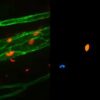Utilizing an innovative experimental model incorporating 240,000 strains of brewer’s yeast descended from two common “parents,” USC and Stanford University researchers published a new study providing insight into the genetic basis of heritable traits. These findings, published March 18 in Nature Communications, may provide an important new tool for clinical, biological and agricultural applications.
At the core of the research is the relationship between additive genetic effects—where two or more genetic markers for the same trait combine to form a visible trait, or phenotype—and non-additive. These latter genetic effects, dominance and epistasis, either mask or modify the effects of other genetic markers when forming a phenotype, respectively. Together, these three effects govern how a genotype is expressed as a phenotype.
The basic additive model for how multiple genetic factors give rise to inherited traits hasn’t changed in a century. However, scientists can now investigate the role genetic markers play in exhibiting, diminishing or modifying phenotypes at unprecedented depth, thanks to exponential increases in sequencing technology and computing power. These new insights would not have been possible a decade ago, according to USC’s Ian Ehrenreich, associate professor of biological sciences and co-author of the study.
“This study and others taking place right now show that the old additive model has worked well but has some major issues,” he said. “It’s not very effective if you want to predict what’s going to be the phenotype of a particular individual. Why? Because biological systems often don’t behave like simple statistical models.
“Biological systems are made of genes that work together. When you change multiple genes, often the effects don’t appear to be additive like the old model suggests. Our work shows that even where alleles are heterozygous—or where the inherited genes don’t match in the same individual—they will behave differently than expected because of polymorphisms—or mutations—that are present at other loci in an organism.”
Handful of large-effect genetic factors make outsized impact on visible traits
Central to the study is the 240,000 individual diploid strains of Saccharomyces cerevisiae, or brewer’s yeast. The researchers utilized a chromosomally encoded double barcoding system to generate and estimate the fitness of a panel of strains grouped in hundreds of families—the result of more than four years of work.
The team found thousands of genetic markers, or loci, “including at least an order of magnitude more genetic interactions than discovered in previous yeast crosses.” The results showed phenotypic variation is largely determined by a handful of key loci that have major additive and dominance effects. Even with the centrality of their role, genetic background—all of the other loci present in an individual—can modify or even completely mask their effects due to genetic interactions. The authors noted that “heritable traits in yeast are more genetically complex than formerly appreciated.”
“Our work supports the premise that, to the extent possible, focusing on groups of more closely related individuals, such as the families studied here, can enhance statistical power and precision relative to populations with greater diversity,” the authors wrote. “The genetic insights gained from these more closely related groups can then be leveraged to inform the genetic architecture of traits in more diverse populations in which many critical genetic effects may otherwise be obscured.”
Genetic background’s pivotal role to phenotypic variation will “likely hamper efforts to predict phenotype from genotype,” the authors concede. But the finding that large-effect loci greatly impacted each other and may account for many, if not most, of the genetic effects may hold promise to researchers in other fields.
Clinical research in personalized medicine depends on achieving a predictive understanding of how genomes produce traits. In agriculture, the development of plants and livestock that are productive in different parts of the world—which may be deteriorating—is a pressing need in a world beset by climate change. This new study gives researchers a more sophisticated understanding of how to approach precision medicine, drought-resistant plants and increased crop productivity.
“The way agriculture has worked historically is by taking different strains, combining their polymorphisms into a new strain and trying to see if that’s better than what you had before,” Ehrenreich said. “Our study provides insights into the rules by which that may work.
“Natural selection depends on genetic variation in a population—how is it that natural selection acts on a variation? The types of effects we’re describing in this study basically mute the ability of natural selection because if a polymorphism isn’t visible in some individuals, or it’s heightened in some but not others, that’s going to alter how natural selection can operate on those variants.”
More information:
Takeshi Matsui et al, The interplay of additivity, dominance, and epistasis on fitness in a diploid yeast cross, Nature Communications (2022). DOI: 10.1038/s41467-022-29111-z
Provided by
University of Southern California
Citation:
Experimental study provides new insights into the genetics of heritable traits (2022, March 18)



